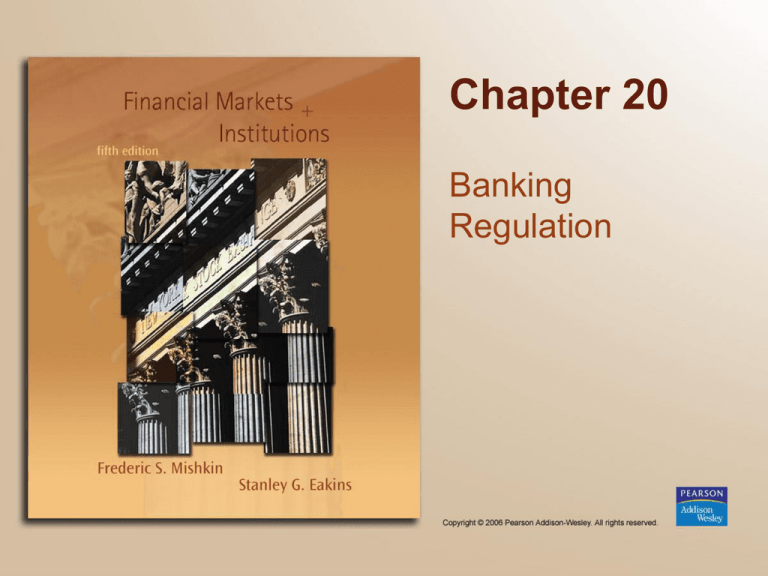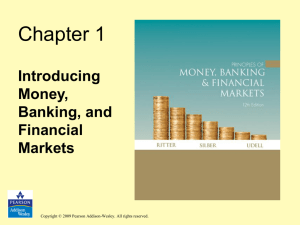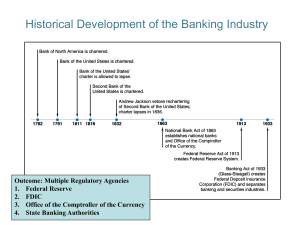
Chapter 20
Banking
Regulation
Chapter Preview
• We examine why financial institutions are
so heavily regulated and, further, why it
takes the form it does. We see further that
regulation doesn’t always work, and offer
an explanation for the world banking crisis
and reforms to prevent future disasters.
Topics include:
– Asymmetric Information and Bank Regulation
– International Banking Regulation
Copyright © 2006 Pearson Addison-Wesley. All rights reserved.
20-2
Chapter Preview (cont.)
– The 1980s U.S. Banking Crisis
– Federal Deposit Insurance Corporation
Improvement Act of 1991
– Banking Crisis Throughout the World
Copyright © 2006 Pearson Addison-Wesley. All rights reserved.
20-3
Asymmetric Information
and Bank Regulation
• Our previous analysis of asymmetric
information, moral hazard, and adverse
selection provide an excellent backdrop for
understanding the current regulatory
environment in banking.
• There are seven basic categories of bank
regulation, which we will examine from an
asymmetric information perspective.
Copyright © 2006 Pearson Addison-Wesley. All rights reserved.
20-4
Asymmetric Information
and Bank Regulation
1. Government Safety Net: Deposit Insurance and the FDIC
•
Prior to FDIC insurance, bank failures meant depositors lost
money, and had to wait until the bank was liquidated to receive
anything. This meant that “good” banks needed to separate
themselves from “bad” banks, which was difficult for banks
to accomplish.
•
The inability of depositors to assess the quality of a bank’s
assets can lead to panics. If depositors fear that some banks
may fail, their best policy is to withdraw all deposits, leading to a
bank run, even for “good” banks.
Copyright © 2006 Pearson Addison-Wesley. All rights reserved.
20-5
Asymmetric Information
and Bank Regulation
1. Government Safety Net: Deposit Insurance and
the FDIC
• Bank panics did occur prior to the FDIC, with major
panics in 1819, 1837, 1857, 1873, 1884, 1907, and
1930-1933.
• By providing a safety net, depositors will not flee the
banking system at the first sign of trouble. Indeed,
between 1934 and 1981, fewer than 15 banks failed
each year.
Copyright © 2006 Pearson Addison-Wesley. All rights reserved.
20-6
Asymmetric Information
and Bank Regulation
1. Government Safety Net: Deposit Insurance and
the FDIC
• The FDIC handles failed banks in one of two ways:
the payoff method, where the banks is permitted to
fail, and the purchase and assumption method, where
the bank is folded into another banking organization.
• Implicit insurance is available in some countries
where no explicit insurance organization exists.
Copyright © 2006 Pearson Addison-Wesley. All rights reserved.
20-7
Asymmetric Information
and Bank Regulation
1. Government Safety Net: Deposit Insurance and
the FDIC
• The FDIC insurance creates moral hazard incentives
for banks to take on greater risk than they otherwise
would because of the lack of “market discipline” on
the part of depositors.
• The FDIC insurance creates adverse selection.
Those who can take advantage of (abuse) the
insurance are mostly likely to find banks attractive.
Copyright © 2006 Pearson Addison-Wesley. All rights reserved.
20-8
Asymmetric Information
and Bank Regulation
1. Government Safety Net: Deposit Insurance
and the FDIC
• Regulators are reluctant to let the largest
banks fail because of the potential impact on
the entire system. This is known as the “Too
Big to Fail” doctrine. This increases the
moral hazard problem for big banks and
reduces the incentive for large depositors to
monitor the bank.
Copyright © 2006 Pearson Addison-Wesley. All rights reserved.
20-9
Asymmetric Information
and Bank Regulation
1. Government Safety Net: Deposit Insurance
and the FDIC
• Consolidation has created many “large”
banks, exasperating the too-big-to-fail
problem. Further, banks now engage in more
than just banking, which may inadvertently
extend FDIC to such activities as
underwriting.
Copyright © 2006 Pearson Addison-Wesley. All rights reserved.
20-10
Asymmetric Information
and Bank Regulation
2. Restrictions on Asset Holdings and Bank
Capital Requirements
• Regulations limit the type of assets banks
may hold as assets. For instance, banks may
not hold common equity.
• Banks are also subject to capital
requirements. Banks are required to hold a
certain level of capital (book equity) that
depends on the type of assets that the bank
holds.
Copyright © 2006 Pearson Addison-Wesley. All rights reserved.
20-11
Asymmetric Information
and Bank Regulation
2. Restrictions on Asset Holdings and Bank Capital
Requirements
• Details of bank capital requirements:
• Leverage ratio must exceed 5% to
avoid restrictions
• Capital must exceed 8% of the banks risk-weighted
assets and off-balance sheet activities (details
follow)
• New capital requirements are forthcoming to
address problems with risk-weighted assets
Copyright © 2006 Pearson Addison-Wesley. All rights reserved.
20-12
Calculating Capital Requirements
First National Bank
Assets
Reserves
Treasury securities
Government agency
securities
Municipal bonds
Residential mortgages
Real estate loans
C&I loans
Fixed assets
Copyright © 2006 Pearson Addison-Wesley. All rights reserved.
Liabiliti es
$3 m
$10 m
$7 m
$10 m
$10 m
$20 m
$35 m
$5 m
Checkable deposits
Nontransactions
deposits
Borrowings
$20 m
$60 m
Loan loss reserves
Bank capital
$2 m
$7 m
$11 m
20-13
Calculating Capital Requirements
• Leverage Ratio = Capital/Assets
= $7m/$100m = 7%
• Bank is well capitalized
Copyright © 2006 Pearson Addison-Wesley. All rights reserved.
20-14
Calculating Risk-Adjusted
Requirements
0 $3 million
+0 $10 million
+ .20 $7 million
+ .50 $10 million
+ .50 $10 million
+1.00 $20 million
+1.00 $35 million
+1.00 $5 million
+1.00 $20 million
$91.4 million
Copyright © 2006 Pearson Addison-Wesley. All rights reserved.
(Reserves)
(Treasury securities)
(Agency securities)
(Municipal bonds)
(Residential mortgages)
(Real estate loans)
(Commercial loans)
(Fixed assets)
(Letters of credit)
(Total risk-adjusted assets)
20-15
Calculating Risk-Adjusted
Requirements
• Core Capital Requirement
= 4% x risk-adjusted assets
= 4% x $91.4m = $3.66m
< $7m of core capital
• Total Capital Requirement
= 8% x risk-adjusted assets
= 8% x $91.4m = $7.31m
< $9m of total capital
= $7m of core + $2m of loan loss reserves
Copyright © 2006 Pearson Addison-Wesley. All rights reserved.
20-16
Asymmetric Information
and Bank Regulation
2. Restrictions on Asset Holdings and Bank
Capital Requirements
The next four slides show how to
calculate Bank Capital requirements for
a fictitious bank.
Copyright © 2006 Pearson Addison-Wesley. All rights reserved.
20-17
How Asymmetric Information
Explains Banking Regulation
3. Bank Supervision: Chartering and Examination
•
•
•
Reduces the adverse selection problem of risktakers or crooks owning banks to engage in highly
speculative activities. Charters may simply not
be granted.
Examinations assign a CAMEL rating to a bank,
which can be used to justify cease and desist orders
for risky activities.
Period reporting (call reports) and frequent
(sometimes unannounced) examinations allow
regulators to address risky / questionable practices
in a prompt fashion.
Copyright © 2006 Pearson Addison-Wesley. All rights reserved.
20-18
How Asymmetric Information
Explains Banking Regulation
4. Assessment of Risk Management
•
Past examinations focused primarily on the quality of
assets. A new trend has been to focus on whether
the bank may take excessive risk in the near future.
•
Four elements of risk management and control:
1. Quality of board and senior management oversight
2. Adequacy of policies limiting risk activity
3. Quality of risk measurement and monitoring
4. Adequacy of internal controls to prevent fraud
Copyright © 2006 Pearson Addison-Wesley. All rights reserved.
20-19
How Asymmetric Information
Explains Banking Regulation
5. Disclosure Requirements
• Better information reduces both moral
hazard and adverse selection problems
6. Consumer Protection
• Standardized interest rates (APR)
• Prevent discrimination (e.g., CRA)
Copyright © 2006 Pearson Addison-Wesley. All rights reserved.
20-20
How Asymmetric Information
Explains Banking Regulation
7. Restrictions on Competition
• Branching restrictions, which reduced
competition between banks
• Separation of banking and securities
industries: Glass-Steagall. In other words,
preventing nonbanks from competing with
banks.
Copyright © 2006 Pearson Addison-Wesley. All rights reserved.
20-21
Bank Regulation
The number of laws and legislation that
regulate banks continues to grow. The
table on the next slide indicates major
banking legislation in the 20th century and
its key provisions.
Copyright © 2006 Pearson Addison-Wesley. All rights reserved.
20-22
Major Banking Legislation in U.S.
Copyright © 2006 Pearson Addison-Wesley. All rights reserved.
FDIC index of regulations on banking
http://www.fdic.gov/regulations/laws/index.html
20-23
Major Banking Legislation
in U.S. (cont.)
Copyright © 2006 Pearson Addison-Wesley. All rights reserved.
FDIC index of regulations on banking
http://www.fdic.gov/regulations/laws/index.html
20-24
International Banking Regulation
• Bank regulation abroad is similar to that in
the United States.
• There is a particular problem of regulating
international banking and can readily shift
business from one country to another (e.g.,
BCCI scandal) and requires coordination
of regulators in different countries (a
difficult task).
Copyright © 2006 Pearson Addison-Wesley. All rights reserved.
20-25
The 1980s Banking Crisis
• Why?
1.Decreasing profitability: banks take risk to
keep profits up
2.Financial innovation creates more
opportunities for risk taking
3.Innovation of brokered deposits enables
circumvention of $100,000 insurance limit
• Result: Failures and risky loans
Copyright © 2006 Pearson Addison-Wesley. All rights reserved.
20-26
Federal Deposit Insurance Corporation
Improvement Act (FDICIA) of 1991
Following the widespread failure of thrift
institutions in the late 1980s, the Bush
administration proposed a set of legislation to
overhaul the supervision and insurance for the
thrift industry. As part of this, the FSLIC was
dissolved and the FDIC assumed responsibility
for insuring thrift institutions. To address the new
needs of the FDIC, the Improvement Act of 1991
was passed.
Copyright © 2006 Pearson Addison-Wesley. All rights reserved.
20-27
Federal Deposit Insurance Corporation
Improvement Act (FDICIA) of 1991
• FDIC recapitalized with loans, ability to borrow
from the Treasury, and higher premiums to
member banks
• Reduce scope of deposit insurance and too-bigto-fail
– Eliminate deposit insurance entirely
– Lower limits on deposit insurance
– Eliminate too-big-to-fail
– Coinsurance
Copyright © 2006 Pearson Addison-Wesley. All rights reserved.
20-28
Federal Deposit Insurance Corporation
Improvement Act (FDICIA) of 1991
• Prompt corrective action provisions
1. Critics believe too many loopholes
2. However: accountability increased by mandatory
review of bank failure resolutions
• Risk-based premiums
• Annual examinations and stricter reporting
• Enhances Fed powers to regulate
international banking
Copyright © 2006 Pearson Addison-Wesley. All rights reserved.
20-29
Banking Crisis Throughout the World
As the next two slides illustrates, banking
crisis have struck a large number of
countries throughout the world, and many
of them have been substantially worse
than ours.
Copyright © 2006 Pearson Addison-Wesley. All rights reserved.
20-30
Banking Crisis Throughout the World
Figure 20.2 Banking Crises Throughout the World Since 1970
Copyright © 2006 Pearson Addison-Wesley. All rights reserved.
20-31
Cost of Banking Crises
in Other Countries
Copyright © 2006 Pearson Addison-Wesley. All rights reserved.
20-32
Banking Crisis Throughout the World
• Latin America
– Many banks were government owned with interest rate
restrictions similar to Regulation Q.
– Similar loan losses and bailout experience as the U.S.
in the late 1980s.
– Argentina ran into government confidence problem,
causing required rates on government debt to
exceed 25%, which caused severe problems for the
banking industry.
– Losses and bailouts as a percent of GDP are high
(20% +) relative to that in the U.S. (around 3%).
Copyright © 2006 Pearson Addison-Wesley. All rights reserved.
20-33
Banking Crisis Throughout the World
• Russia and Eastern Europe
– Many banks were government owned prior to
the downfall of communism.
– Private banks had little experience screening
and monitoring loans.
– Substantial loan losses ensued.
– The bailout in Russia alone may exceed
$15 billion
Copyright © 2006 Pearson Addison-Wesley. All rights reserved.
20-34
Banking Crisis Throughout the World
• Japan
– Prior to the 1980s, Japan’s financial markets
were heavily regulated. Deregulation led to
excessive risk taking and high loan losses,
particularly in real estate loans.
– Several large bank failures were announced in
1995. Several failures followed in 1996
and 1997.
Copyright © 2006 Pearson Addison-Wesley. All rights reserved.
20-35
Banking Crisis Throughout the World
• Japan
– Japan is experiencing similar regulator
forbearance policies as the U.S. in the
early 1980s.
– Even with positive steps, bad loans throughout
the banking system had reaches over $1 trillion
in 2001.
– System is still a long way from being healthy.
Copyright © 2006 Pearson Addison-Wesley. All rights reserved.
20-36
Banking Crisis Throughout the World
• China
– Many banks were government owned.
– Investments in many state-owned enterprises,
which are notoriously inefficient.
– Current attempt at a bailout calls for partial
privatization of the biggest banks.
Copyright © 2006 Pearson Addison-Wesley. All rights reserved.
20-37
Banking Crisis Throughout the World
• East Asia
– Lending boom in the aftermath of
liberalization led to substantial loan losses.
– Nonperforming loans and bailout costs
exceeding 20% of GDP are commonplace.
Copyright © 2006 Pearson Addison-Wesley. All rights reserved.
20-38
Chapter Summary
• Asymmetric Information and Bank Regulation: the
problems of adverse selection and moral hazard
were reviewed. These ideas are the basis for
exploring the regulatory environment of the
banking industry.
• International Banking Regulation: The challenges
of international regulation, particularly
international banks, was discussed.
Copyright © 2006 Pearson Addison-Wesley. All rights reserved.
20-39
Chapter Summary (cont.)
• The 1980s U.S. Banking Crisis: We
examined the causes of the U.S. crisis.
Further, we explored problems caused by
the political environment in fixing the
problem promptly.
• Federal Deposit Insurance Corporation
Improvement Act of 1991: The provisions of
this act and its implications for the safety of
the banking system were explored.
Copyright © 2006 Pearson Addison-Wesley. All rights reserved.
20-40
Chapter Summary (cont.)
• Banking Crisis Throughout the World: As
reviewed, evidence suggests that the U.S.
is not alone in its banking problems, as
other countries face similar issues as the
U.S. in the late 1980s.
Copyright © 2006 Pearson Addison-Wesley. All rights reserved.
20-41







